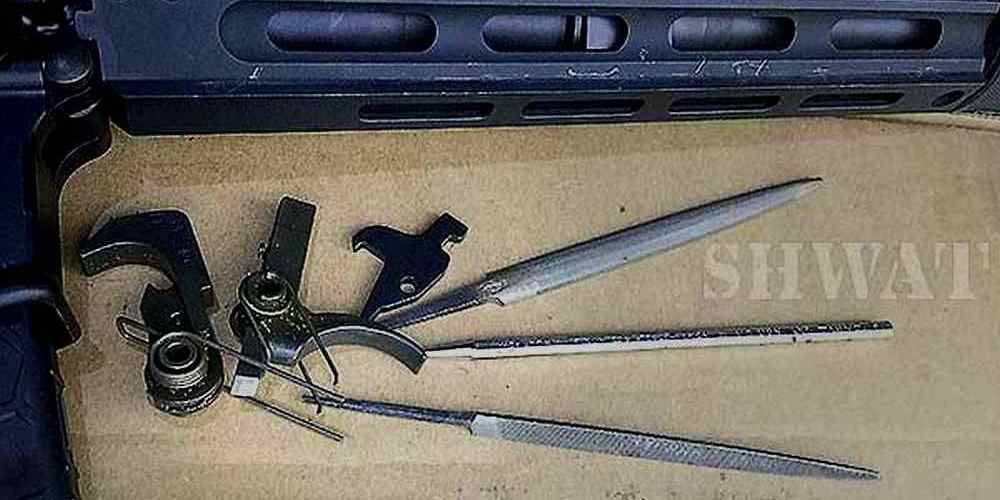“Evolution of precision: A timeline of AR15 trigger systems”
Evolution of AR15 Trigger Systems
The AR15 rifle has a long and storied history, dating back to its development in the 1950s by Eugene Stoner. One of the key components of the AR15 is its trigger system, which has undergone significant evolution over the years to improve performance and user experience.
In the early days of the AR15, the trigger system was relatively simple, consisting of a single-stage trigger that provided a consistent pull weight. This design was effective for its time, but as shooters began to demand more precision and control from their rifles, manufacturers began to explore new trigger designs.
One of the first major advancements in AR15 trigger systems came in the form of the two-stage trigger. This design featured a lighter initial pull weight followed by a heavier break weight, allowing shooters to take up the slack in the trigger before applying more pressure to fire the rifle. This design proved popular among precision shooters and hunters, as it provided a more predictable and consistent trigger pull.
As technology continued to advance, manufacturers began to experiment with different materials and coatings to improve the performance of AR15 trigger systems. Titanium, aluminum, and stainless steel were all used to create lighter and more durable triggers, while coatings such as nickel boron and DLC (diamond-like carbon) were applied to reduce friction and improve overall feel.
In recent years, the rise of aftermarket trigger manufacturers has further pushed the boundaries of AR15 trigger design. Companies like Geissele Automatics, Timney Triggers, and CMC Triggers have all introduced innovative new designs that offer improved performance and customization options for shooters.
One of the most popular advancements in AR15 trigger systems in recent years has been the introduction of adjustable triggers. These triggers allow shooters to fine-tune the pull weight and reset of their triggers to suit their individual preferences, providing a level of customization that was previously unheard of in the AR15 platform.
Another key development in AR15 trigger systems has been the introduction of drop-in trigger assemblies. These pre-assembled trigger units can be easily installed in place of the factory trigger, providing shooters with a quick and easy way to upgrade their rifle’s performance without the need for gunsmithing.
Overall, the evolution of AR15 trigger systems has been a testament to the ingenuity and innovation of the firearms industry. From the simple single-stage triggers of the past to the advanced adjustable triggers of today, shooters have more options than ever before to customize their AR15 rifles to suit their individual needs and preferences.

As technology continues to advance, it’s likely that we’ll see even more advancements in AR15 trigger systems in the years to come. Whether it’s improved materials, new coatings, or innovative new designs, one thing is certain – the AR15 trigger system will continue to evolve to meet the demands of shooters looking for the ultimate in performance and precision.
Key Innovations in AR15 Trigger Development
The AR15 rifle has a long and storied history, dating back to its development in the 1950s by Eugene Stoner. One of the key components of the AR15 is its trigger system, which has undergone significant development over the years to improve performance and user experience.
One of the earliest innovations in AR15 trigger systems was the introduction of the two-stage trigger. This design features a first stage that takes up the slack in the trigger pull, followed by a second stage that breaks cleanly and predictably. This design allows for greater control and accuracy when shooting, making it a popular choice among shooters.
Another important development in AR15 trigger systems was the introduction of adjustable triggers. These triggers allow users to customize the weight and pull of the trigger to suit their preferences, making it easier to achieve consistent and accurate shots. Adjustable triggers have become a standard feature on many modern AR15 rifles, giving shooters greater control over their weapon.
In recent years, trigger manufacturers have focused on improving the overall feel and performance of AR15 triggers. One of the most significant advancements in trigger technology has been the introduction of drop-in trigger systems. These systems are pre-assembled and can be easily installed in an AR15 rifle without the need for gunsmithing. Drop-in triggers offer a smoother and more consistent pull, making them a popular choice among shooters looking to upgrade their rifle’s performance.
Another key innovation in AR15 trigger development has been the introduction of enhanced trigger components, such as nickel boron-coated triggers and sears. These components offer increased durability and reduced friction, resulting in a smoother and more reliable trigger pull. Enhanced trigger components have become a popular choice among competitive shooters and enthusiasts looking to improve the performance of their AR15 rifle.
In addition to improved trigger components, trigger manufacturers have also focused on developing new trigger designs to enhance performance. One such design is the flat-faced trigger, which features a wider surface area for the shooter’s finger to rest on. This design provides a more consistent trigger pull and improved control, making it a popular choice among precision shooters.
Overall, the development of AR15 trigger systems has come a long way since the rifle’s inception. From two-stage triggers to adjustable triggers and drop-in trigger systems, shooters now have a wide range of options to choose from to customize their AR15 rifle to suit their needs. With continued advancements in trigger technology, the future looks bright for AR15 trigger systems and the shooters who rely on them for accuracy and performance.
Historical Impact of AR15 Trigger Systems
The AR15 rifle has a long and storied history, dating back to its development in the 1950s by Eugene Stoner. One of the key components of the AR15 is its trigger system, which has undergone significant development over the years to improve performance and reliability.
In the early days of the AR15, the trigger system was a simple single-stage design. This meant that when the trigger was pulled, it released the hammer directly, firing the rifle. While this design was effective, it had its limitations in terms of accuracy and consistency.
As the AR15 gained popularity among military and civilian shooters, manufacturers began to experiment with different trigger designs to improve performance. One of the first major advancements in trigger systems came with the introduction of the two-stage trigger.
A two-stage trigger is designed to provide a more consistent and predictable trigger pull. The first stage of the trigger pull takes up the slack in the trigger, while the second stage releases the hammer to fire the rifle. This design allows for greater control and accuracy, making it a popular choice among competitive shooters and marksmen.
In addition to the two-stage trigger, manufacturers also began to develop adjustable triggers for the AR15. These triggers allow the user to customize the weight and pull of the trigger to suit their individual preferences. This level of customization has made adjustable triggers a popular choice for shooters who demand precision and consistency from their rifles.
Another major development in AR15 trigger systems came with the introduction of drop-in trigger assemblies. These assemblies are pre-assembled and can be easily installed in place of the factory trigger system. This makes it quick and easy for shooters to upgrade their trigger without the need for specialized tools or gunsmithing skills.
In recent years, trigger manufacturers have continued to push the boundaries of innovation with the introduction of electronic triggers for the AR15. These triggers use electronic sensors to detect trigger pull and release the hammer, providing a faster and more consistent trigger pull. While electronic triggers are still relatively new to the market, they have quickly gained popularity among competitive shooters and tactical operators.
Overall, the history of AR15 trigger systems is a testament to the ongoing commitment to innovation and improvement in the firearms industry. From simple single-stage designs to advanced electronic triggers, the evolution of AR15 trigger systems has revolutionized the way shooters interact with their rifles.
Whether you are a competitive shooter looking for precision and consistency, or a tactical operator in need of a reliable trigger system, there is a wide range of options available to suit your needs. The development of AR15 trigger systems has come a long way since the early days of the rifle, and the future looks bright for continued advancements in this critical component of the AR15 platform.
Notable Manufacturers in AR15 Trigger History
The AR15 rifle has a long and storied history, with its trigger system playing a crucial role in its development. Over the years, many manufacturers have contributed to the evolution of AR15 trigger systems, each bringing their own unique innovations to the table.
One of the most notable manufacturers in AR15 trigger history is Geissele Automatics. Founded by Bill Geissele in 2004, Geissele has become synonymous with high-quality, precision triggers for the AR15 platform. Their triggers are known for their smooth, crisp break and minimal take-up, making them a favorite among competitive shooters and tactical operators alike.
Another key player in the world of AR15 triggers is Timney Triggers. Founded in 1946 by Allen Timney, the company has a long history of producing top-notch triggers for a variety of firearms, including the AR15. Timney triggers are known for their reliability and consistency, with many shooters swearing by their products for both competition and hunting applications.
Yet another manufacturer that has made a significant impact on AR15 trigger systems is CMC Triggers. Founded in 2003, CMC is known for their innovative drop-in trigger designs that offer a crisp, clean break with minimal overtravel. Their triggers are popular among shooters looking to upgrade their AR15 without having to do any gunsmithing work.
One of the newer players in the AR15 trigger market is Elftmann Tactical. Founded in 2012 by Tim Elftmann, the company has quickly made a name for itself with its innovative trigger designs that offer unmatched performance and reliability. Elftmann triggers are known for their incredibly short reset and light pull weight, making them a favorite among competitive shooters.
Rise Armament is another manufacturer that has made waves in the world of AR15 triggers. Founded in 2014, Rise Armament is known for their high-quality triggers that offer a smooth, consistent pull with minimal creep. Their triggers are popular among shooters looking for a reliable, affordable upgrade for their AR15 rifles.
In conclusion, the history of AR15 trigger systems is a rich and diverse one, with many manufacturers contributing to the evolution of this crucial component. From Geissele and Timney to CMC and Elftmann, each company has brought its own unique innovations to the table, helping to push the boundaries of what is possible with AR15 triggers. Whether you’re a competitive shooter, a tactical operator, or just a firearms enthusiast, there is no shortage of high-quality trigger options available for your AR15 rifle.
Future Trends in AR15 Trigger Technology
The AR15 rifle has been a staple in the firearms industry for decades, known for its reliability, accuracy, and customization options. One key component of the AR15 that has seen significant development over the years is the trigger system. The trigger is a critical part of any firearm, as it is responsible for initiating the firing sequence. In this article, we will explore the history of AR15 trigger systems and how they have evolved over time.
The original AR15 trigger system was a simple single-stage design, which means that the trigger pull is consistent from start to finish. While this design was effective, it left room for improvement in terms of trigger feel and performance. As shooters began to demand more from their rifles, manufacturers started to develop new trigger systems that offered improved performance and customization options.
One of the first major advancements in AR15 trigger technology was the introduction of two-stage triggers. A two-stage trigger has a distinct break point, where the trigger pull weight increases before the shot is fired. This design allows for a lighter initial pull, followed by a more deliberate break, which can help improve accuracy and control. Two-stage triggers quickly gained popularity among shooters who valued precision and consistency in their shooting.
In recent years, trigger manufacturers have continued to push the boundaries of AR15 trigger technology with the development of adjustable triggers. Adjustable triggers allow shooters to customize the weight and feel of their trigger pull to suit their preferences. This level of customization was previously unheard of in the firearms industry and has revolutionized the way shooters interact with their rifles.
Another significant development in AR15 trigger technology is the rise of drop-in trigger systems. Drop-in triggers are pre-assembled units that can be easily installed in an AR15 rifle without the need for gunsmithing. These triggers offer a quick and convenient way to upgrade the performance of a rifle without the hassle of traditional trigger installations. Drop-in triggers have become increasingly popular among shooters who want to improve the performance of their rifles without breaking the bank.
Looking ahead, the future of AR15 trigger technology is bright, with manufacturers continuing to innovate and push the boundaries of what is possible. One trend that is gaining traction in the industry is the use of electronic triggers. Electronic triggers use sensors and microprocessors to control the firing sequence, offering unparalleled precision and consistency. While electronic triggers are still relatively new to the market, they have the potential to revolutionize the way shooters interact with their rifles.
In conclusion, the history of AR15 trigger systems is a story of innovation and progress. From simple single-stage designs to advanced electronic triggers, the evolution of AR15 trigger technology has been driven by a desire for improved performance and customization options. As shooters continue to demand more from their rifles, manufacturers will undoubtedly rise to the challenge, pushing the boundaries of what is possible in AR15 trigger technology. The future of AR15 trigger systems is bright, with exciting developments on the horizon that promise to revolutionize the way shooters interact with their rifles.








